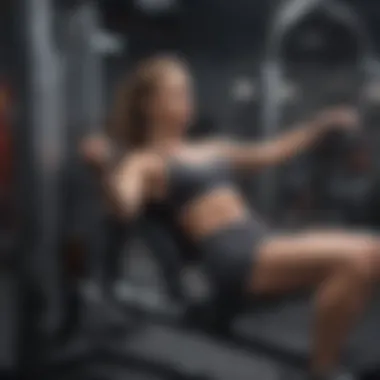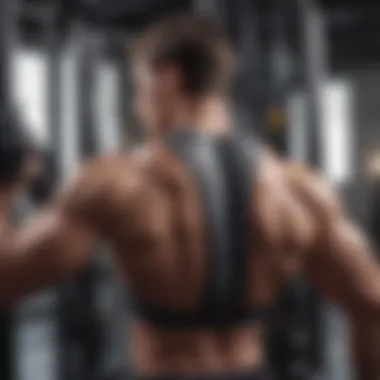Maximizing Back Strength with Gym Machines


Intro
Back workouts play a crucial role in developing a strong and resilient physique. While free weights are popular among fitness enthusiasts, gym machines offer unique benefits that can enhance back training. This article focuses on the optimization of back workouts using gym machines, outlining their specific advantages, types, and guidelines for proper use. By providing a comprehensive understanding of machine-based workouts, the content aims to cater to fitness novices and seasoned practitioners alike.
Machine workouts in the gym are designed to target specific muscle groups, ensuring safe and effective training. They offer controlled movements that help maintain proper form, reducing the risk of injury. Additionally, gym machines can be adjusted to accommodate different fitness levels and personal goals. This adaptability makes them suitable for various users, from beginners learning basic movements to experienced athletes refining their techniques. Understanding how to effectively incorporate these machines into a workout regimen can lead to significant benefits in overall back strength and development.
Key Benefits
Utilizing gym machines for back workouts provides several key benefits that span physical health and mental well-being.
Physical Health Benefits
- Targeted Muscle Activation: Gym machines are designed to isolate specific muscles, allowing focused training of the back, such as the latissimus dorsi, rhomboids, and trapezius. This targeted approach enhances muscle development effectively and promotes better posture.
- Reduced Injury Risk: The designs of gym machines often enhance stability during workouts. This stability decreases the likelihood of injuries that can arise from improper form when using free weights. Machines can help users maintain correct posture throughout exercises, ensuring a safe training environment.
- Adjustable Resistance Levels: Many machines allow users to customize resistance levels according to their strength. This feature enables progressive overload, which is essential for muscle growth while accommodating continuous improvement.
- Improved Range of Motion: Certain machines facilitate movements that may be difficult to achieve with free weights alone. They often provide a guided path, allowing users to experience a full range of motion while targeting the back muscles effectively.
Mental Well-being Enhancements
Beyond the physical benefits, using gym machines can also contribute to improved mental health in several ways:
- Increased Confidence: As individuals become more adept at using machines, they often experience a boost in confidence. This can translate into a more positive relationship with fitness and overall well-being.
- Reduction of Anxiety: Structured workouts with machines can create a sense of routine, which may alleviate anxiety and provide mental clarity. Knowing that the equipment is designed for their safety allows users to focus more on their performance.
- Encouragement of Routine: The accessibility of machines can motivate individuals to maintain consistent exercise habits. This regularity supports overall mental health and resilience against stress.
"The importance of technique and machine selection cannot be overstated in optimizing workouts. Selecting the right equipment, coupled with proper form, can create a significant impact on results."
To maximize these benefits, it is essential to understand the different types of machines available and how each can support specific workout goals. By integrating this knowledge into a fitness routine, users can effectively enhance their back strength and overall performance.
Intro to Back Workouts
Back workouts are crucial in any fitness regime, offering significant benefits for strength, posture, and overall health. This article focuses on optimizing back workouts using gym machines. A strong back helps in daily activities, sports performance, and injury prevention. By understanding how to use gym machines effectively, individuals can improve their fitness outcomes and their back health.
Understanding the Importance of a Strong Back
A strong back is often taken for granted until it becomes weak or injured. It supports nearly every movement we make and plays a critical role in overall body balance. Muscles of the back, such as the latissimus dorsi, trapezius, and rhomboids, aid in various functions including lifting, pulling, and twisting. If these muscles are neglected, it can result in weakness and poor posture. Poor back strength can lead to conditions like muscle strain and long-term spinal issues. By emphasizing back workouts, one can develop stability and core strength. Incorporating appropriate gym machines makes these workouts more efficient, especially for beginners or those recovering from injuries.
Common Types of Back Injuries
Understanding common back injuries is essential for anyone engaging in physical activity. Some of the most frequent injuries include:
- Muscle Strains: Occur when muscles are stretched or torn, often due to overexertion during workouts or lifting heavy weights.
- Herniated Discs: Happen when discs between the vertebrae bulge or rupture, leading to pain and discomfort.
- Sciatica: A condition that arises when the sciatic nerve is pinched, causing pain that radiates down the leg.
It's crucial to recognize these injuries to prevent them. Utilizing gym machines correctly can minimize risks. Machines provide resistance and structure to workouts, allowing for safer exercise as opposed to free weights. Therefore, when considering back workouts, the type of equipment and its use cannot be overlooked. Awareness and technique can greatly reduce injury likelihood while maximizing benefits.
Gym Machines for Back Development
Utilizing gym machines specifically for back development has gained significant attention in the fitness community for good reason. These machines allow for a controlled environment to strengthen the back muscles, which are critical for overall stability and posture. They target various muscle groups effectively, promoting balanced muscle development and minimizing the risk of injuries through improper form. In this section, we will delve into the specifics of these machines, their operational dynamics, and how they contribute to a robust fitness routine.
Overview of Back Machines
Back machines are designed to isolate and work specific muscles in the back. They include various types, such as the lat pulldown, seated row, back extension, and cable machines. Each machine focuses on different parts of the back, including the latissimus dorsi, trapezius, and lower back muscles. This variety enables users to develop a comprehensive approach to back training, catering to their individual fitness goals.
Machines like the lat pulldown allow for vertical pulling motions, targeting the upper back. The seated row machine emphasizes horizontal pulls, effectively working on the mid-back region. Meanwhile, the back extension machine promotes strength in the lower back, supporting spine health. Lastly, cable machines offer versatility for various movements, allowing for both pulling and pushing exercises which can engage multiple muscle groups simultaneously. An effective workout routine may include a combination of these machines to ensure balanced development.


Benefits of Using Gym Machines
The benefits of incorporating gym machines into back workouts are multifaceted.
- Controlled Movements: Machines offer a set range of motion, which is particularly advantageous for beginners. This helps learn proper form and builds strength with reduced chance of injury.
- Targeted Muscle Isolation: Machines allow for isolating specific muscle groups without involving secondary muscles excessively. This is crucial for focused development, especially when recovering from an injury.
- Scalability: Weights on most machines can be adjusted without the requirement of a partner. This independence is beneficial for individuals who prefer to increase or decrease resistance according to their capabilities.
- Safety: Using machines often feels safer than free weights for some individuals. The risk of dropping weights or losing balance is minimized, encouraging more users to engage in back workouts with confidence.
- Versatility: Many machines offer several exercises that can target different back muscles. This adaptability allows for diverse workout routines without the need for additional equipment.
In summary, gym machines for back development provide essential benefits that can guide effective strength training. They optimize workout efficiency, enhance safety, and permit tailored exercise regimens that cater to diverse fitness levels. This efficiency enhances the overall effectiveness of back workouts, rendering machines an indispensable part of a comprehensive fitness program.
"Strengthening the back is essential not just for athletes, but for anyone seeking improved posture and reduced injury risk."
Engaging with these machines thoughtfully and systematically can yield optimal results in back strength, paving the way for broader fitness pursuits.
Types of Back Workout Machines
In crafting an effective back workout regimen, understanding the different types of back workout machines is essential. Each machine serves a unique purpose and targets specific muscle groups within the back. Knowing these distinctions helps individuals make informed choices that align with their fitness goals. This section delineates various machines commonly found in gyms, providing insights into their function and key benefits.
Lat Pulldown Machine
The lat pulldown machine is designed primarily to develop the latissimus dorsi muscles, which are the large muscles of the back. This coverage not only promotes a wider back appearance but also enhances overall upper body strength. When using this machine, the user typically sits down, secures their knees under a pad, and pulls a bar down towards their chest.
Key benefits of the lat pulldown include:
- Targeted Muscle Development: It isolates the lats effectively, enabling focused development.
- Adjustable Load: Users can vary the resistance levels, making it suitable for beginners and advanced athletes alike.
- Reduction of Injury Risk: The machine setting often provides more stability than free weights, giving individuals an easier way to learn and maintain proper form.
Seated Row Machine
The seated row machine targets the mid-back, including the rhomboids and traps. It aids in building thickness and strength in the midsection of the back. Users sit on a bench, pull a handle towards themselves while keeping their back straight. This machine promotes excellent posture and strength in the upper body.
Benefits of the seated row machine are as follows:
- Engagement of Multiple Muscle Groups: It effectively engages not just the back but the biceps as well.
- Strengthening the Posture: Regular use helps to improve posture, especially for those with sedentary jobs.
- Ease of Use: Like the lat pulldown machine, this machine allows for controlled movements, reducing the chance of injuries.
Back Extension Machine
Back extension machines are specifically designed to strengthen the lower back, which is crucial for overall back health. Users position themselves on a padded bench, securing their legs, and then raise their upper body using their lower back muscles.
The primary benefits of the back extension machine include:
- Targeted Lower Back Strength: This machine reinforces the muscles surrounding the spine, reducing the risk of chronic pain or injury.
- Core Stability Improvement: It helps enhance core stability, which is vital for overall body strength and function.
- Adaptability: Various machines offer different ranges of motion, allowing users to find a comfortable position.
Cable Machines for Back Workouts
Cable machines are versatile tools in a gym that can be tailored for many types of back exercises. With adjustable pulleys and a variety of attachment options, these machines allow for an extensive range of movements that target different areas of the back.
Key points regarding cable machines are:
- Versatility: Users can perform numerous exercises such as cable rows, face pulls, and straight-arm pulldowns.
- Continuous Tension: They provide continuous tension on the muscles throughout the movement, enhancing growth and strength.
- Functional Training: Cable machines mimic real-life movements, making them advantageous for functional training.
Understanding these various types of back workout machines forms the foundation for optimizing back workouts. The right choice of machines can significantly influence the effectiveness of training, leading to better results and reduced injury risks.


How to Use Gym Machines Effectively
Using gym machines correctly is vital for maximizing the benefits of your back workouts. Understanding the nuances of machine operation not only enhances performance but also reduces the risk of injury. This section elaborates on essential aspects such as setup, posture, and common mistakes to promote safe and effective exercise practices.
Setting Up the Machine
Proper setup of gym machines is fundamental to achieve optimal results. Each machine has specific adjustments to ensure it aligns with your body dimensions. Start by adjusting the seat height, backrest, and handles. Here are steps to follow:
- Position the Seat: Adjust the seat so that your knees are aligned with the pivot point of the machine.
- Set the Backrest: Ensure your back is fully supported without excessive strain. This provides stability during exercise.
- Handle Adjustments: Adjust handles or grips to suit your reach, enabling a full range of motion without discomfort.
Make sure to perform a test run. Use light weights to affirm that all settings accommodate your body.
Correct Posture and Technique
Posture and technique significantly influence the effectiveness of workouts. A good stance reduces the potential for injuries and ensures the targeted muscles are engaged. Here are key components of maintaining correct posture:
- Engage the Core: Activating your core helps stabilize the spine during exercises.
- Shoulder Position: Keep shoulders back and down, avoiding rounding, to prevent strain on the neck.
- Knees and Feet: Position knees in line with feet. Avoid letting knees collapse inward during movements.
Using proper technique also involves slowing down the motion. Focus on the muscle contraction and avoid using momentum. This encourages better muscle engagement and development.
Avoiding Common Mistakes
Even experienced gym-goers can make errors that detract from their workouts. Recognizing these mistakes can enhance performance:
- Neglecting Warm-up: Always warm up before using machines to prepare muscles and joints for exertion.
- Inconsistent Tempo: Lifting too fast can lead to hypertension injuries. Maintain a steady and controlled pace.
- Ignoring Body Signals: Pay attention to your body. If you feel pain beyond normal discomfort, stop and reassess.
"Form is essential. Concentrate on controlling the weight and maintaining a proper stance to reap full benefits."
Adhering to these guidelines will optimize your gym machine experience for back workouts. It ensures that each session is productive and safe, allowing for continued progress in developing back strength.
Creating an Effective Back Workout Routine
Creating an effective back workout routine is crucial for anyone looking to enhance their overall strength and health. It involves careful planning and an understanding of how various gym machines can be utilized to achieve specific fitness goals. A well-structured routine can lead to improved posture, reduced risk of injury, and greater functional strength in daily activities.
It is essential to adopt an approach that considers individual goals, fitness levels, and body types. Personalization of workouts can provide a more engaging experience and lead to better results. In addition, when gym machines are integrated thoughtfully, they can complement other forms of training, allowing for a more rounded workout.
Integrating Machines into Your Routine
When integrating machines into your routine, it’s important to choose the right equipment for your specific needs. Selecting machines such as the lat pulldown or seated row can effectively target various muscles in the back. Gradually introducing machines at the beginning of a workout allows for optimal fatigue distribution, which is beneficial especially for those who are newer to strength training.
To make the most of machine workouts, consider the following:
- Vary Your Routine: Change the types of machines or exercises every few weeks to prevent boredom and promote progress.
- Focus on Form: Proper technique is vital. Ensure that you are utilizing the machine in a way that supports good posture and alignment.
- Progressive Overload: Aim to gradually increase weights or resistance to continue challenging your muscles.
This integration is not just about using machines but also about understanding how they fit into your larger fitness regimen.
Balancing Machine Use with Free Weights
While machines offer many advantages, like stability and guided motion, free weights provide unique benefits, including increased muscle activation and improved coordination. Striking a balance between machine use and free weights is essential. Each has its place in a comprehensive training plan.


For effective balance:
- Start with Machines: For beginners, starting with machines can build confidence and teach basic movements before progressing to free weights.
- Supplement with Free Weights: Incorporating dumbbells and barbells can enhance muscle engagement by challenging stabilizers and promoting functional fitness.
- Create Hybrid Workouts: Mix machine workouts with free weight exercises to create a diverse training experience, targeting muscles from various angles.
Tracking Progress and Making Adjustments
Tracking progress is vital for maintaining motivation and ensuring that workout routines are effective. Consider keeping a workout journal or using fitness apps to log performance metrics. Key indicators to monitor include:
- Lift Weights: Track how much weight you are lifting over time.
- Reps and Sets: Keep a record of repetitions and sets for different exercises.
- Form Quality: Reflect on whether your form is improving as you gain strength.
Based on your records, adjustments can be made. If you are not progressing, consider increasing weight, modifying rep schemes, or changing exercises. Adjustments should be made in a thoughtful way to continue promoting strength gains while avoiding injury.
"The key to an effective workout routine is not just hard work but also smart planning."
Safety Considerations
Importance of Warm-Up and Cool Down
Before starting a rigorous back workout, a warm-up is essential. It prepares the muscles for exertion, increases blood flow, and enhances flexibility. This may help to reduce the risk of strains or pulls during the workout. A comprehensive warm-up could involve light cardio, dynamic stretches, or specific movements targeting the back area.
After the workout, it is just as crucial to perform a cool down. Cooling down facilitates recovery and helps to prevent muscle stiffness. This can involve lower-intensity exercises and static stretching focused on the back muscles.
Tips for effective warm-up and cool down include:
- Start with 5-10 minutes of light aerobic exercise, such as jogging on the treadmill or using the elliptical machine.
- Incorporate dynamic stretches like arm circles and torso twists.
- After workout, devote at least 5-10 minutes to static stretching, targeting the upper and lower back.
"A proper warm-up and cool down can substantially reduce the chance of injury and improve overall performance."
Recognizing Signs of Injury
Understanding how to recognize signs of injury is critical for anyone engaging in back workouts. Ignoring warning signals can lead to chronic pain and long-term damage. Common indicators of injury include:
- Unusual or acute pain in the back during workouts.
- Persistent soreness that lasts beyond usual muscle fatigue.
- Difficulty in performing routine movements, such as bending or rotating the torso.
- Sudden weakness or numbness in the limbs, which may suggest nerve involvement.
If any of these symptoms occur, it is important to cease the workout and consult a healthcare professional if necessary. Early intervention can often prevent more serious injuries and ensure a safer approach to back training.
Ending
In the context of this article, the conclusion serves as a critical component in reinforcing the strategies for optimizing back workouts using gym machines. By synthesizing the knowledge shared throughout the article, the conclusion distills essential insights into actionable takeaways. This reflection not only encapsulates the importance of effective machine usage but also emphasizes how aligning techniques with the right equipment can significantly enhance workout outcomes.
Summary of Key Takeaways
Several key points emerge from the discussion regarding back workouts with gym machines. Understanding the machines available is foundational, as each one targets specific muscle groups for effective strengthening. The lat pulldown machine is ideal for latissimus dorsi development, while the seated row machine enhances upper back strength and posture. Additionally, integrating sufficient warm-up and cooldown practices is vital for injury prevention.
- Diverse Machine Options: Various types of machines exist, designed for specific purposes.
- Proper Set-Up is Essential: Correct machine set-up prevents injury and ensures maximum efficiency.
- Technique Matters: Adhering to posture and equipment usage guidelines enhances results.
- Balance Activation: Using machines in conjunction with free weights can yield comprehensive back development.
Encouragement to Prioritize Back Health
Promoting back health should be a consistent theme in any fitness journey. A strong back not only supports overall physical ability but also guards against injuries and promotes daily functional movement. This is particularly relevant for fitness professionals and trainers, who should instill a culture of back health among clients.
Effective back workouts utilizing gym machines can be a cornerstone for enduring health. Regularly evaluating and adjusting workouts, along with learning to heed the body’s signals, can lead to major benefits in terms of strength and durability.
Prioritizing back exercises in routines creates an investment in one’s well-being that extends beyond the gym. It's essential to remember that a focus on the back can improve not only athletic performance but also overall quality of life.
Ultimately, as with any fitness regimen, individualizing back workout plans through the intelligent use of gym machines is the pathway to achieving long-term back health.















